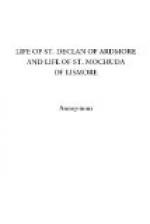1. The most blessed Bishop Declan of the most noble race of the kings of Ireland, i.e., the holy bishop who is called Declan was of the most noble royal family of Ireland—a family which held the sceptre and exacted tribute from all Ireland at Tara for ages. Declan was by birth of noble blood as will appear from his origin and genealogy, for it was from Eochaidh Feidhleach, the powerful Ardrigh of Ireland for twelve years, that he sprang. Eochaidh aforesaid, had three sons, scil.:—Breas, Nar, and Lothola, who are called the three Finneavna; there reigned one hundred and seven kings of their race and kindred before and after them, i.e. of the race of Eremon, king of Ireland,—before the introduction of Christianity and since. These three youths lay one day with their own sister Clothra, daughter of the same father, and she conceived of them. The son she brought forth as a consequence of that intercourse was marked by three red wavy lines which indicated his descent from the three youths aforesaid. He was named Lugaidh Sriabhdearg from the three lines [sriabaib] in question, and he was beautiful to behold and of greater bodily strength in infancy than is usual with children of his age. He commenced his reign as king of Ireland the year in which Caius Caesar [Caligula] died and he reigned for twenty-six years. His son was named Criomthan Nianair who reigned but sixteen years. Criomthan’s son was named Fearadach Finnfechtnach whose son was Fiacha Finnolaidh whose son again was Tuathal Teachtmhar. This Tuathal had a son Felimidh Reachtmhar who had in turn three sons—Conn Ceadcathach, Eochaidh Finn, and Fiacha Suighde. Conn was king of Ireland for twenty years and the productiveness of crops and soil and of dairies in the time of Conn are worthy of commemoration and of fame to the end of time. Conn was killed in Magh Cobha by the Ulstermen, scil.:—by Tiopruid Tireach and it is principally his seed which has held the kingship of Ireland ever since. Eochaidh Finn was second son to Felimidh Reachtmhar and he migrated to the latter’s province of Leinster, and it is in that province his race and progeny have remained since then. They are called Leinstermen, and there are many chieftains and powerful persons of them in Leinster. Fiacha Suighde moreover, although he died before he succeeded to the chief sovereignty, possessed land around Tara. He left three sons—Ross, Oengus, and Eoghan who were renowned for martial deeds—valiant and heroic in battle and in conflict. Of the three, Oengus excelled in all gallant deeds so that he came to be styled Oengus of the poisonous javelin. Cormac Mac Art Mac Conn it was who reigned in Ireland at this time. Cormac had a son named Ceallach who took by force the daughter of Eoghan Mac Fiacha Suighde to dwell with him, i.e. Credhe the daughter of Eoghan. When Oengus Gaebuaibhtheach ("of the poisonous javelin”) heard this, viz., that the daughter of his brother had been abducted




